The first Italian guided missile destroyers
 Built 1958-64, in service 1991-1992: Impavido, Intrepido DD 570-571
Built 1958-64, in service 1991-1992: Impavido, Intrepido DD 570-571
The Impavido class were the second group of destroyers built for the Italian Navy after World War II, but they were also the first Italian guided missile destroyers, often compared to the US Charles Adams class. But they were still essentially improved Impetuoso-class ships with an aft turret replaced by a Tartar surface-to-air-missile launcher. Only two ships were built in the 1960s in Italy, Impavido and Intrepido, active in the end of the cold war in 1991-1992. They were replaced by a second generation of missile destroyers, the Audace class. #marinamilitare #italiannavy #coldwar #impavido #intrepido
Rebuilding a destroyer fleet
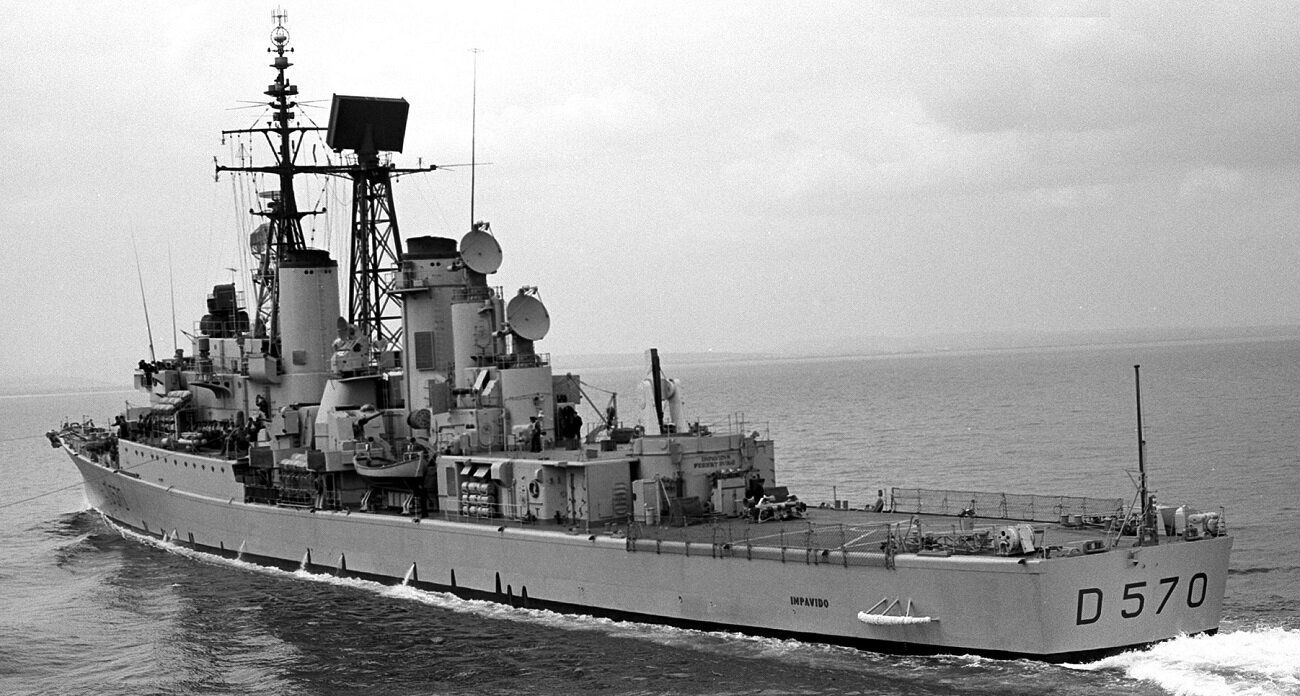
Impavido’s stern, unk src, via warthunder forum
The to rebuilt its destroyer fleet led the Italian admiralty in search of a new design while were modernizing five surviving WW2 destroyers (Grecale, Artigliere, Carabiniere, Granatiere and Fuciliere rebuilt with new bridges, Modern sonar, radar, new DC racks and DCT and later reclassified as frigates.) in the 1950s of various classes and two former Capitani Romani class cruisers rebuilt and renamed San Giorgio and San Marco as large AA destroyers. The first naval plan to determine the Marina Militare’s needs was established FY1949 and a year later in 1950 the “no submarine” bab was lifted by the allied commission. The new class would comprise initially four modern destroyers to be built in existing naval yards, fully repaired under MDAP with US funds.
One crucial point was Italy joining NATO, benefiting Marshall plan funds and leading to a more ambitious FY1950 plan looking at a five-year reconstruction program. The Marina Militare’s staff planned to operate a 6,000 ton cruiser, two 4,000 ton AA cruisers, six versatile 2,500 ton destroyers and in 1951 a new class of Italian-built destroyers was planned FY1952, the Impetuoso class.
There was a second calss planned in 1957, at first gun-armed, but reconverted as missile destroyers, becoming among the very first in Europe. In 1969 as the two Impavido class had entered service, the USA under MDAP transferred three Fletcher DDE that became the Lanciere class (Lanciere, Fante, Geniere) to achieve five modern destroyers, then seven with the Impavido class.
Development
For the previous class, Impetuoso, the naval staff started with the last, unrealized Italian destroyer design, the “Commandante Medaglie d’Oro” (21 ordered, none completed, only Commander Margottini launched, the rest BU on slip). In 1948 the design was considered obsolete and at best they could have four single dual purpose guns and a radar. The same year, the Italian admiralty looked at destroyer designs such as the recent Gearing class and started to design a new ship, flush deck, that would blend caracteristics.
To gain time, armament and electronics would be under US standard, as confirmed in 1950 when the preliminary design was approved. Long story short, the Impetuoso class was the result. They were built in 1952–1958 and constituted the first generation of conventional cold war destroyers. By “conventional” we understand “gun-armed” as it was the distinction made at the time. Today the new norm is a guided missile destroyer. They were consideration to fit them with 135mm guns as on the modernized Giuseppe Garibaldi instead of US-type 5-in/38s well before they were ordered in 1957 and 1959.
Initially planned in 1955 they became an improved convential and then re-designed again to make a leap forward to be missile capable, thanks to US weapons and radar tech, allowing to save perhaps a decade of development. The Impavido class thus became the first guided missile destroyers of the Italian Navy. They were compared often to the American Charles F. Adams-class destroyers between the look, armament and capabilities, but were smaller. Both class indeed followed the same evolution of the Forrest Sherman to the Charles Adams.
The core of the new design will be the adoption of the Tartar missile system, Mk 13 launcher, 40 missiles in store as replacement for the aft turret and two fire control radars, also aft. The comparisons stopped there however as to gain time in design, the team choose to keep the Mk 38 twin turrets instead of adoption a more modern single Mk 42 127 mm (5 in) gun as in the Charles Adams. This was a tradeoff, but an equivalent of the Mark 42 was orked on at the time by OTO Melara and not ready in time to be delivered to the new class.
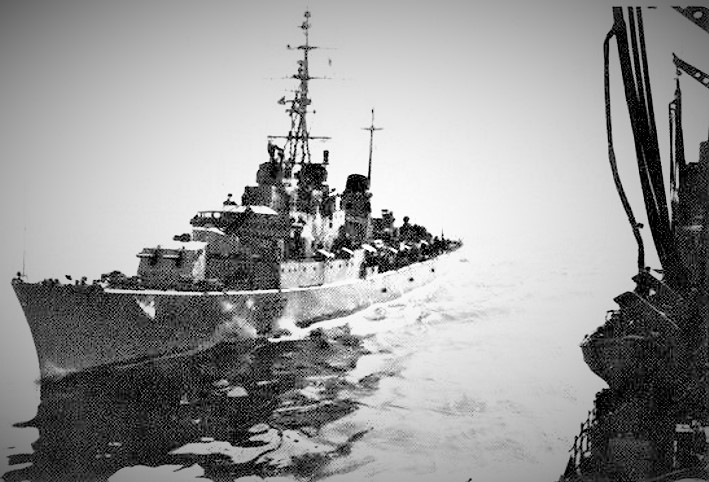
The previous Impetuoso
There was also another design difference between the Impavido and Charles Adams, their secondary armament, and while both shared Mk 48 triple lightweight ASW torpedo launchers, the Adams class had an ASROC launcher, while the Impavidos had four MM 76 mm (3 in) guns for extra close-in AA defence as aerial threat in the confirned of the Mediterranean were considered a greater danger than the Soviet submarines coming from the Black sea fleet. This was conformed with the Audace and Durand de la Penne, which had also a heavier short-range air defence panoply than other destroyers of the time. But these now OTO Melara guns had no full auto mode and if fast-firing, they had initially reliability issues. Another long term assessment critique about the Impavido design is that they lacked a proper modernization during their long three decades career, although both their Tartar was replaced by the Standard and whole radar suite upgraded in the 1970s, but nothing happened in the 1980s. Their former sisters were removed from serice at the same time.
Design of the Impavido
Hull and general arrangements
Essentially the same design as their forebears the Impetuosos, with the same stepped layout, two funnels intertwined with lattice masts, blocky bridge structure, upper decks fore and aft, and a flush deck recalling those of the Gearing class, but with cruise-style bulwarks at the prow, and transom stern. The main structtures compared to the Impetuoso were “busy”, bulkier, with a less clean layout and double stepped bridge two rows of windows in the main turrion such as the contemporary Alpino-class frigates. Single turret forward on deck, large derrick mast amidship in between funnel, the other placed forward of the forefunnel on bridge, large clean surface aft, as the Tartar SAM was located on a cylindrical elevated mount.
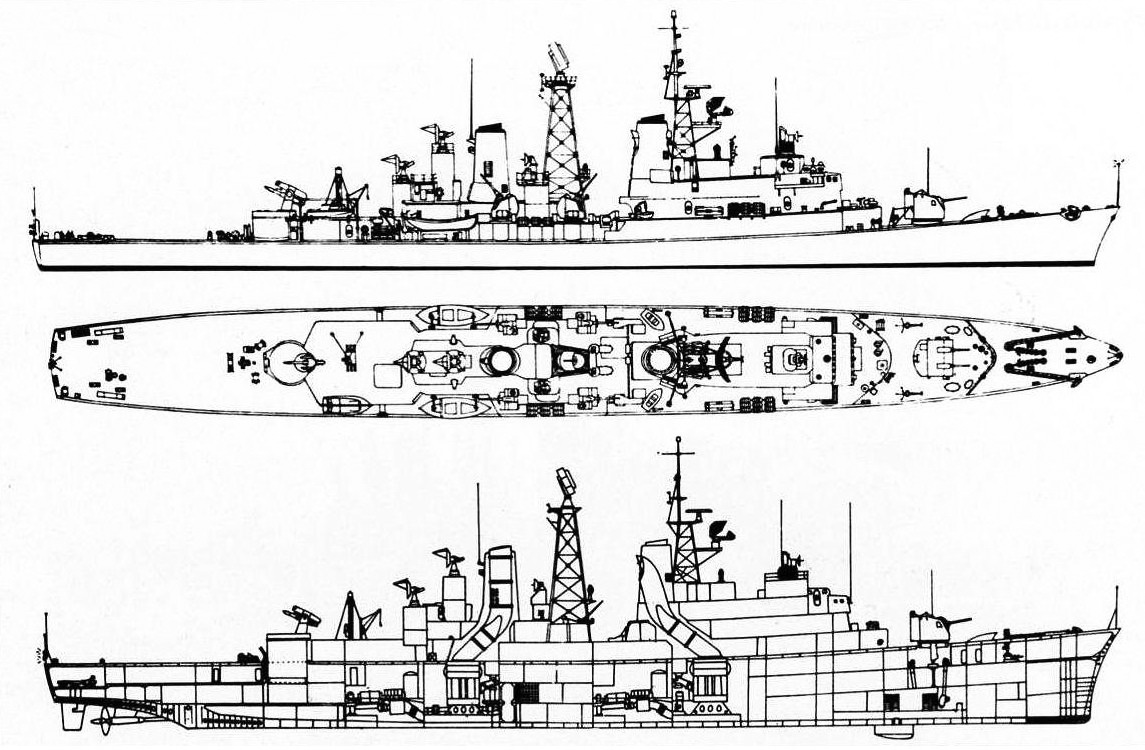
Profile, elevation and cutaway of the class, unknown src. Pinterest.
The hull had a central quarterdeck connected towards the stern by a large deckhouse, at the end of which there the Tartar missile launcher and at extreme stern a well cleared helipad, reinforced to support the weight of a Sea King helicopter. The superstructure was divided into two blocks, the first of which housed the control bridge towards the bow, on the top of which there was the direction of fire of the bow gun and towards the stern the first of the two tall funnels delfecting aft. The first block was surmounted by the foremast on which various electronic equipment were placed, including the naval air detection radar and the surface navigation and detection radar. The second block, which housed the second funnel, was surmounted by the mainmast at the top of which was placed the long-range three-dimensional aerial detection radar; on the sides of the second block, two on each side, the four anti-aircraft guns guided by two firing radars arranged one on each side and placed on the second block deck. Aft of the second funnel are the two missile guidance radars and the single anti-aircraft missile launcher.
Powerplant
It was essentially the same as for the Impetuoso’s, but improved to reach 70,000 hp instead of 65,000 hp. Two shaft driven by two Tosi geared turbines, fed by four Foster Wheeler boilers providing a total output of 52,000 kW, top speed of 34 knots (63 km/h; 39 mph) and 3,300 nmi (6,100 km; 3,800 mi) tange at 20 knots (37 km/h; 23 mph), roughly same as their forebears.
The four Foster Wheeler boilers fueled by oil fuelled the turbines which were connected to the propellers shafts by two turboreduction units. The speed in normal operations fully loaded was below 30 knots. Nominal range was 5,000 miles at 16 knots. The engine system was still close to the Indomito’s but presneted improvements, as the division into two non-contiguous spaces, completely independent of each other on their own shaft line for survivability, and offering the possibility of remote control. The automation of the propulsion allowed for more economical and functional conduct and considerable flexibility for rapid changes in speed. The next Audace class would adopt the same powerplant essentially, no CODOG or assimilated system.
Armament
The Impavidos kept two dual purpose gun turrets as a factor multiplier to performe AS, AAW and ASW tasks for basic fleet escort duties. NATO “suggested” for the previous class the 5-in (127 mm) caliber as standard, virtually adopted by all nations bar Britain. And there were massive inherited stockpiles of fused 5-in/38 caliber shells that were still very efficient at close range against any incoming aircraft. Thus, the Impavidos, came with a single turret forward.

2-views color profile (pinterest)
Twin 127mm/38
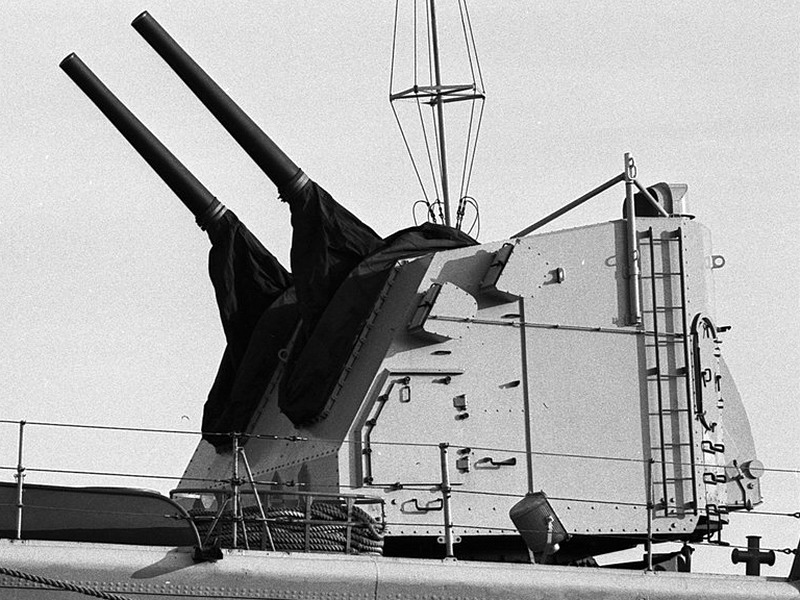
Under updated radar guidance the ship had a Mark 12 assembly gun in Mark 38 Mod 0 enclosed twin turret similar to the Gearing class standards.
In short: −15° to +85°, 15 rpm, Muzzle velocity 2,600 ft/s (790 m/s), range 20 km.
They were guided by a modified Mark 37 FCS topped by the postwar SPG-25 radar antenna, and backed later by SPG-34 fire control radars. This dual weapon was seen in the 1980s as a relic mostly useful for coastal support.
⚙ specifications Mark 38 DP |
|
| Weight | 170,653 lb (77,407 kg) full turret and pannier |
| Barrel lenght | 190 in (4.83 m) bore, 157.2 in (3.99 m) rifling |
| Elevation/traverse | −15° to +85°, 328.5 degrees |
| Loading system | Vertical sliding-wedge, Recoil 15 in (38 cm) |
| Muzzle velocity | 2,600 ft/s (790 m/s) |
| Range | 17,392 yards (15,903 m), Ceiling 37,200 feet (11,300 m) |
| Guidance | Radar guided, Mark 37, SPG-34 |
| Crew | 12 |
| Round | 127×680mmR 55 lb (25 kg) |
| Rate of Fire | 15 rpm |
RIM-24 Tartar SAM
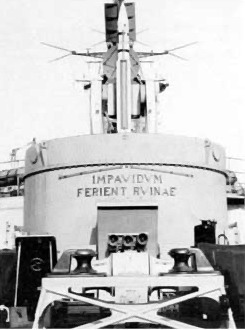 The biggest change in design, this launcher was installed in place of the dual purpose Mark 38 turret. This means also completely modifiying the underdeck arrangements to house a massive conveyor belt and storage for some forty missiles. Also the aft superstructures to support to guidance radars, enabling to simultaneously guide two missiles in flight. Both destroyers in escort could thus provide against any incoming threat a four missile launch. This was a far cry of today’s VLS massive firepower, but were are talking 1960s tech here. The Tartar was provided indeed initial guidance on a director beam and subsequently with semi-active guidance.
The biggest change in design, this launcher was installed in place of the dual purpose Mark 38 turret. This means also completely modifiying the underdeck arrangements to house a massive conveyor belt and storage for some forty missiles. Also the aft superstructures to support to guidance radars, enabling to simultaneously guide two missiles in flight. Both destroyers in escort could thus provide against any incoming threat a four missile launch. This was a far cry of today’s VLS massive firepower, but were are talking 1960s tech here. The Tartar was provided indeed initial guidance on a director beam and subsequently with semi-active guidance.
⚙ specifications MISSILE |
|
| Weight | 1,200 lb (540 kg) |
| Dimensions | 186 in (470 cm) x 13.5 in (34 cm) |
| Propulsion | Dual thrust, Solid-fuel rocket, Solid Rocket Fuel |
| Speed | Mach 1.8 |
| Range | 16 nmi (30 km; 18 mi) (RIM-24B) |
| Guidance | SARH |
| Ceiling | 65,000 ft (20 km) (RIM-24B) |
| Warhead | 130 lb (59 kg) continuous-rod |
533mm TTs
Initially two banks of three as planned. But they were discarded at design stage eand instead, fixed tubes to fire homing torpedoes were installed. They would have been likely 53.3 cm (21″) Si 270/533.4 x 7.2 “M” of ww2 vintage (3,748 lbs./1,700 kg, 23 ft. 7 in./7.200 m, 595 lbs. (270 kg) PL, Wet-heater R 4,400/8,750/13,100 yards/46/35/29 knots) or the US postwar 21″ (53.3 cm) Mark 39.
These tubes were replaced in design by the triple 324 mm Mark 48, see below.
324mm ASWTTs
Placed close to the bridge on the upper deck. Fired the Mark 44 torpedo. The latter weighted 425 lbs. (193 kg) for 100 in (2.540 m) long, carrying a 75 lbs. (34 kg) HBX-3 warhead to 6,000 yards (5,490 m)/30 knots, powered by Electric-Battery, seawater and using Helix search, active acoustic guidance. The light 324 mm wire-guided torpedoes were guided by the onboard M.F. medium frequency sonar AN/SQS-23B.
AA: 4x 76mm/L62 Allargato
Instead of sixteen 40 mm AA guns as in the Impetuoso class (Two quad mounts, four twin mounts), the Impavidos came with four single OTO Melara 76 mm (3 in)/L62 MMI.
The 76mm/L62 Allargato was the fiurst postwar model by OTO Melara largely adopted in the Marina Militare and exported abroad. It was single barrel, medium caliber, dual purpose automatic naval cannon designed in 1958-61 and entering service in 1952. In the 1980s they were ultimately replaced by Otobreda 76 mm series. 84 were produced in all. On the Impavidos they were installed on eith beam, grouped amidship in between funnels on raised broadside mounts, with guiding radars in between. These guns also had anti-ship capabilities and could also be used for coastal firing.
⚙ specifications 76mm/L62 Allargato |
|
| Turret+Mount Weight | 12 tonnes (26,000 lb) |
| Barrel lenght | 62 caliber: 4,724.4 mm (186.00 in) |
| Elevation/Traverse | -15°/+85°, 360°; 40°/sec and 70°/sec |
| Loading system | Magazine, automatic selection, ramming, breech operation |
| Muzzle velocity | 900 m/s (3,000 ft/s) |
| Range | HE 45°: 16,000 m (17,000 yd) |
| Guidance | Radar, see notes |
| Crew | 1 operator |
| Round | Complete 76×636mmR, |
| Rate of Fire | 55/60 rpm |
Depth charges
In addition to a long-range depth charge launcher, there were four short-range DC throwers and a depth charge rack aft, probably “Gatteschi” type.
Sensors
As built:
AN/SPS-12 air search radar
AN/SPS-39 3D radar
AN/SPG-51 fire control radar
AN/SQS-23 sonar
Upgrades:
In 1974-1975, Intrepido and in 1976-1977 Impavido saw the removal of their obsolete Tartar SAM, as well as their Mk 25, SPS-39, and the four SPG-34 fire guidance radars. The SAM was upgraded to the Standard SM-1MR SAM (also 40 RIM-66), and the radar suite was improved with adoption of the SPS-39A 3D radar, the fire control SPN-748 radars and three RTN-10X radars for lignt AA, plus a brand new ECM suite and 2 SCLAR decoy launchers.
Final Suite:
SPS-52 three-dimensional radar: Instead of the SPS-6.
SPS-12 air search radar: Instead of the SG-6B.
Two SPG-51B missile guiding radars: Instead of SPG-34. Tartar Missile target illumination and guidance radars.
Three fire direction NA10 FCS with Orion 10X radar: 76 mm OTO cannon radars.
SPQ2 surface discovery and navigation radar:
SQS23B hull sonar: Instead of SQS-11. Hull mounted.
Helicopter
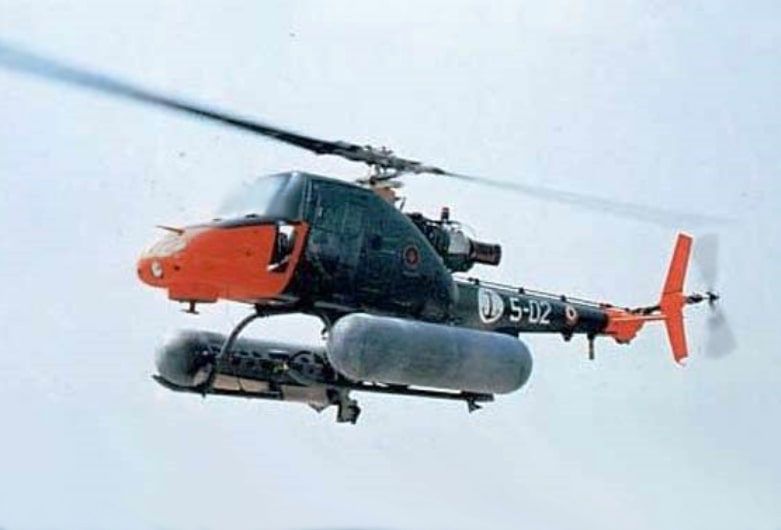
The Impavidos were the first italian destroyers coming as designed with an helideck at the stern. It was able to deploy not an Agusta-Bell AB.212, not ready yet, but the AB 106 instead. It was an Italian licence-built version of the famous Vietnam era Bell Huey. It was planned to be used for SAR, ASW warfare, anti-ship warfare and transportation but there was no hangar not facilities for maintenance. Tests in the 1970s were not encouraging however and the programmed was dropped. The Agusta A.106 was a single-seat light helicopter used for ASW on board the Impavido-class destroyers, with sophisticated electronics from Ferranti, for autostabilisation and contact identification. It could carry two torpedoes slung under the fuselage and both the tail and two-bladed main rotor could be folded for easier stowage while the skid undercarriage could receive flotation bags. Two prototypes were built, maiden flying on November 1965 followed by a pre-production batch of 5 cancelled in 1973.
⚙ Impavido class specifications |
|
| Displacement | 2,829 Tons standard, 3,940 Tonnes FL |
| Dimensions | 130.9 oa x 13.6 x 4.5 m (429 ft 6 in x 44 ft 7 in x 14 ft 9 in) |
| Propulsion | 2 shaft geared turbines, 4× Foster Wheeler boilers, 70,000 hp (52,000 kW) |
| Speed | 34 knots (63 km/h; 39 mph) |
| Range | 650t oil, 6,000 nmi () at 16 kn. |
| Armament | RIM-24B Tartar SAM (40), 1×2 127/38, 4x 76/62 mm AA, 2×3 533mm TTs |
| Sensors | AN/SPS-12, AN/SPS-39, AN/SPG-51, AN/SQS-23 sonar |
| Air group | 1 Agusta-Bell Helicopter |
| Crew | 315-333 |
General assessment
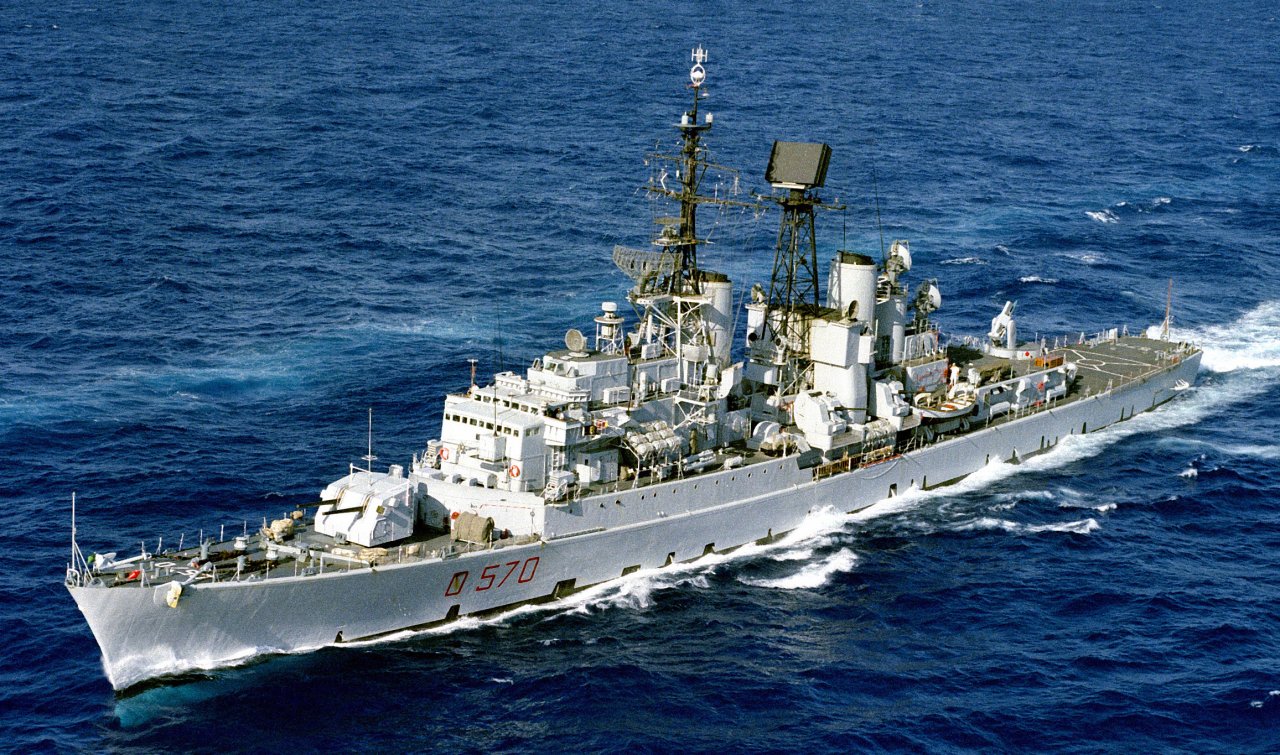
Derived from the previous Impetuoso class of which they retained the general lines of the hull, but with slightly increased displacement and dimensions. They were largely automated ships, both in detection sensors and weapons systems, had a reliable engine were notable for their stability, asd platforms, being equipped with three pairs of Denny Brown stabilizing fins for flexibility of use, making them suitable for operating in escort missions for merchant shipping, and particularly suitable for anti-aircraft and anti-submarine warfare. The stabilization of the hull by reducing the amplitude of the rolling oscillations allowed a more precise use of stabilized weapons and equipment, a greater possibility of using non-stabilised or partially stabilized weapons or equipment, less discomfort for the personnel both in life on board during navigation and in the use of units.
The electronic component made use of a Frescan AN/SPS-39 long-range three-dimensional air detection radar, positioned on the mainmast, consisting of a robust quadripod; on the foremast there was space for both the R.C.A. and naval air discovery radar. AN/SPS-12, positioned on a shelf, is the S.M.A. surface navigation and discovery radar. MM/SPQ-2, placed in a higher position while abaft the second funnel there were the two Raytheon AN/SPG-51 missile guidance radars serving the Tartars. The bow gun’s firing direction was positioned on the top of the bridge and at the top sides of the second block of the superstructure were two NA-9 firing directions, one on each side serving the secondary calibers.
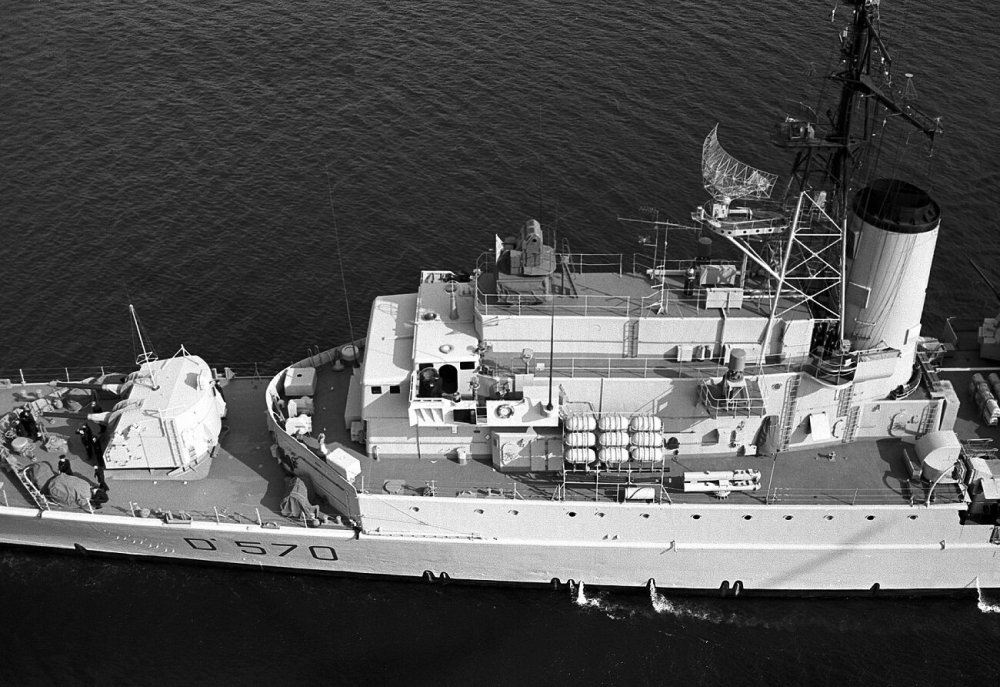
Details of the bridge
Before even the design phase started, the importance of having an helicopter on board was recognised, but it did not appear appropriate to do so without acquiring the necessary experience which was done on the Bergamini class frigates, first helicopter units, built almost simultaneously. There was an urgent need to put them into service, due to Italian destroyers being rapidly ageing at the end of the sixties with the retirement of the Artigliere, Aviere, San Giorgio and San Marco expected. In 1970, testing the Agusta A106 started but night use was difficult and it had a poor autonomy leading to the abandonment of the project in July 1973 while the possibility offered by the platform remained useful.
The modernization program mainly concerned electronics and main armament, with a general improvement ofsensors starting in 1974 and ending in 1977 for the lead ship. Modifications included the single Mk.13 Standard SM-1 launcher with untapped 40 missiles capacity, and two SCLAR Breda/Elsag 105 mm multiple rocket launchers. Gone was the old three-dimensional Frescan AN/SPS-39 radar replaced by Hughes AN/SPS-52, and three Orion RTN 10X control units for the artillery. One was on the top of the command bridge, for the 127mm/38 mm bow guns and the other two in between the 76/62 mm turrets. The powerplant was not forgotten, and converted to the use od lighter diesel fuel as per NATO standardisation.
Career of the Impavido class
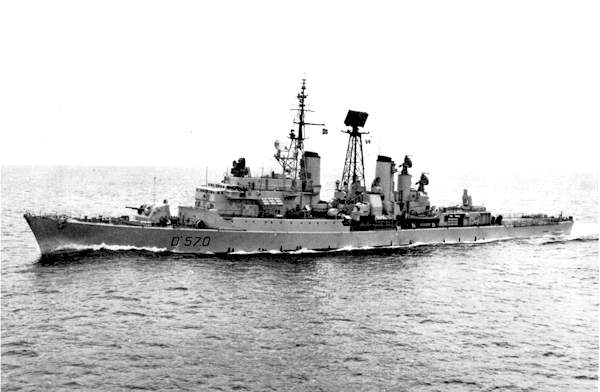
Impavido underway early in her career
They entered service between 1963 and 1964 and in total served for approximately 30 years until decommission between 1991 and 1992, replaced by the new Durand de la Penne class. Intrepido was recoignised and visited, host ship of local authority at a grand ceremony on 2 May 1965 in Savona, receiving the pennant “Vanni Folco”. She was was assigned to the Taranto base from 1963 and her sister Intrepido initially remained in La Spezia, and joined her at Taranto from 1975 where they entered the 2nd Offshore Naval Group, 2nd Naval Division.
They took part in various cruises and missions. They were laid up after their long service back at the Taranto Arsenal, and sold for BU to specialized Neapolitan shipyards (SIMONT S.p.A.) between 1999 and 2000.
 D 570 Impavido
D 570 Impavido
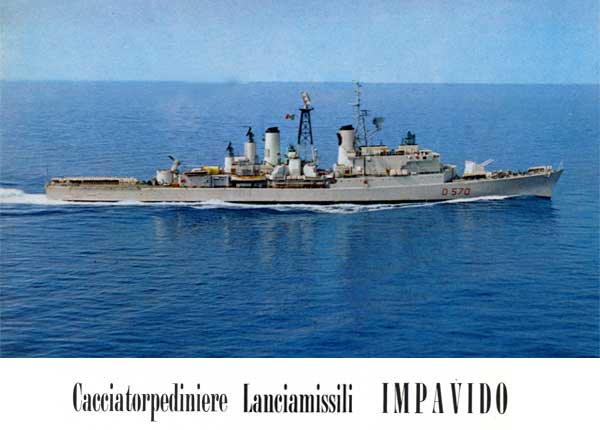
Impavido class
Impavido was laid down on 10 June 1957 and launched on 25 May 1962 at Cantiere navale di Riva Trigoso. She was commissioned on 16 November 1963.
In 1973 Impavido made a summer cruise as training ship for 1st year of Livorno Academy cadets. Following the unavailability of the sailship Amerigo Vespucci, the summer cruise was rescheduled with different itineraries, rotating in teams with Etna, Doria, Impavido and Carabiniere under the command of the vessel captain Pirozzi and later frigate captain Mariotti, visiting Taranto, Suda, Sevastopol, Odessa, Istanbul, and Portoferraio.
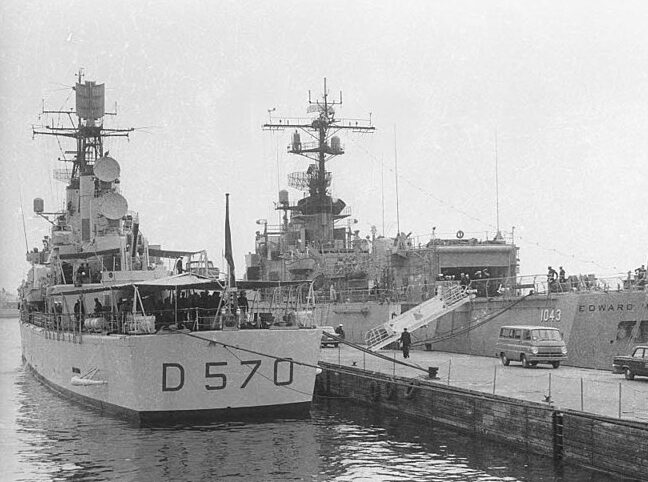
Impavido at the Kiel Week 1966
No detailed records.
She was decommissioned in June 1992.
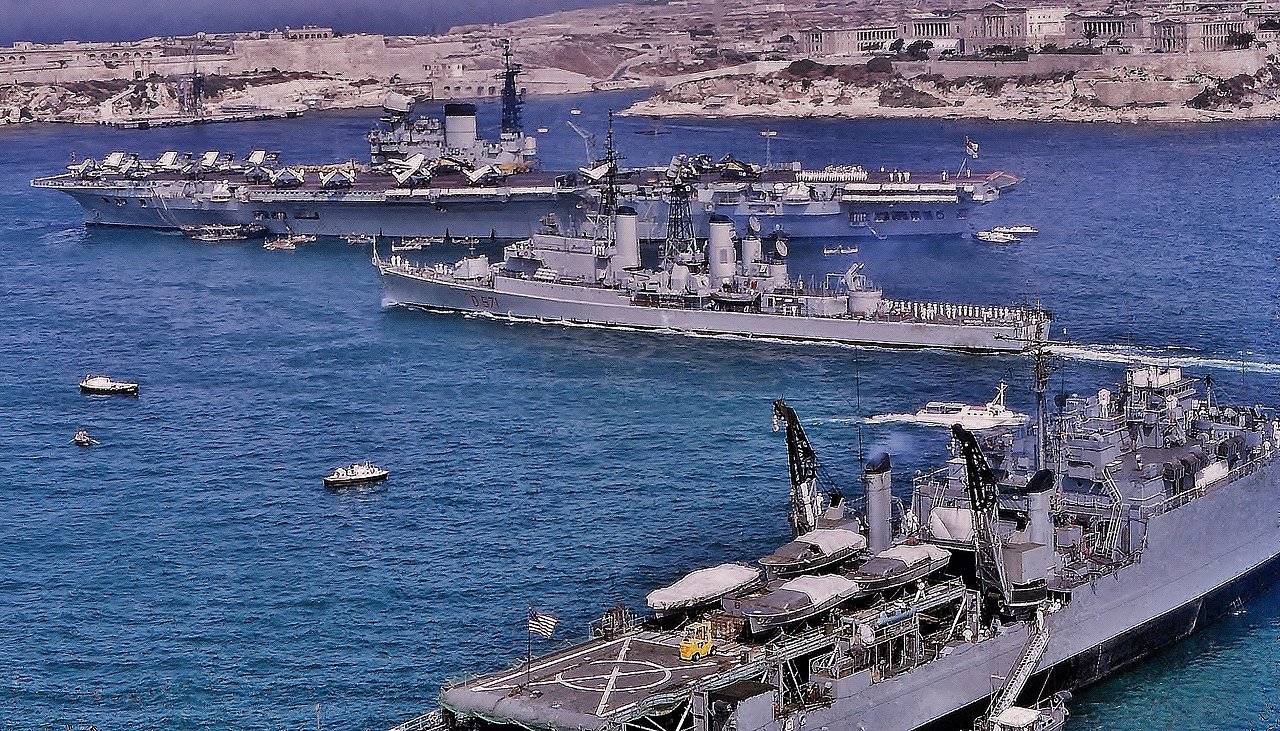
Impavido and Victorious at Malta, 1967
 D 571 Intrepido
D 571 Intrepido
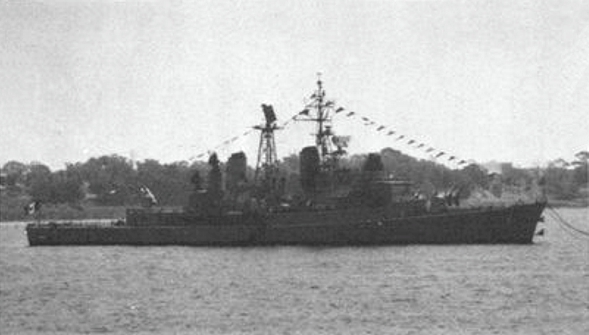
At anchor in 1971
She was laid down on 16 May 1959, launched on 21 October 1962 at Cantiere navale fratelli Orlando and Commissioned on 28 July 1964.
She was decommissioned in August 1991.
No detailed records.
Read More/Src

Impavido, from pinterest
Books
Blackman, Raymond V.B. Jane’s Fighting Ships 1971–72. Sampson Low Marston & Co 1971
Gardiner, Robert and Stephen Chumbley Conway’s All The World’s Fighting Ships 1947–1995.
Links
navypedia.org/
globalsecurity.org
seaforces.org
svppbellum.blogspot.com
naviecapitani.it/
marina.difesa.it/
designation-systems.net
on old-forum.warthunder.com
on en.wikipedia.org


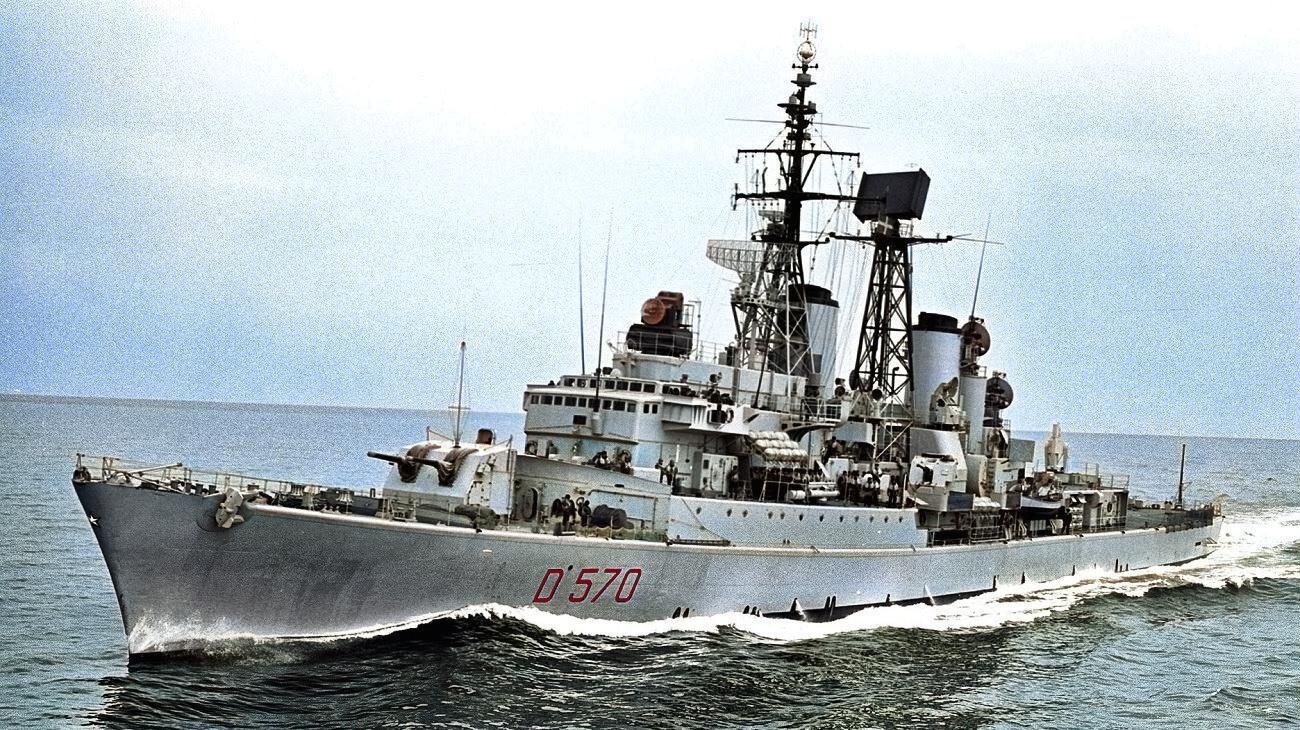
 Latest Facebook Entry -
Latest Facebook Entry -  X(Tweeter) Naval Encyclopedia's deck archive
X(Tweeter) Naval Encyclopedia's deck archive Instagram (@navalencyc)
Instagram (@navalencyc)





 Austrian Navy
Austrian Navy French Navy
French Navy Royal Navy
Royal Navy Armada Espanola
Armada Espanola K.u.K. Kriegsmarine
K.u.K. Kriegsmarine Dansk Marine
Dansk Marine Nautiko Hellenon
Nautiko Hellenon Koninklije Marine 1870
Koninklije Marine 1870 Marinha do Brasil
Marinha do Brasil Osmanlı Donanması
Osmanlı Donanması Marina Do Peru
Marina Do Peru Marinha do Portugal
Marinha do Portugal Regia Marina 1870
Regia Marina 1870 Nihhon Kaigun 1870
Nihhon Kaigun 1870 Preußische Marine 1870
Preußische Marine 1870 Russkiy Flot 1870
Russkiy Flot 1870 Svenska marinen
Svenska marinen Søværnet
Søværnet Union Navy
Union Navy Confederate Navy
Confederate Navy Armada de Argentina
Armada de Argentina Imperial Chinese Navy
Imperial Chinese Navy Marinha do Portugal
Marinha do Portugal Mexico
Mexico Kaiserliche Marine
Kaiserliche Marine 1898 US Navy
1898 US Navy Russkiy Flot
Russkiy Flot French Naval Aviation
French Naval Aviation Russian Naval Aviation
Russian Naval Aviation Sovietskiy Flot
Sovietskiy Flot Royal Canadian Navy
Royal Canadian Navy Royal Australian Navy
Royal Australian Navy RNZN Fleet
RNZN Fleet Chinese Navy 1937
Chinese Navy 1937 Kriegsmarine
Kriegsmarine Chilean Navy
Chilean Navy Danish Navy
Danish Navy Finnish Navy
Finnish Navy Hellenic Navy
Hellenic Navy Polish Navy
Polish Navy Romanian Navy
Romanian Navy Turkish Navy
Turkish Navy Royal Yugoslav Navy
Royal Yugoslav Navy Royal Thai Navy
Royal Thai Navy Minor Navies
Minor Navies Albania
Albania Austria
Austria Belgium
Belgium Columbia
Columbia Costa Rica
Costa Rica Cuba
Cuba Czechoslovakia
Czechoslovakia Dominican Republic
Dominican Republic Haiti
Haiti Hungary
Hungary Honduras
Honduras Estonia
Estonia Iceland
Iceland Eire
Eire Equador
Equador Iran
Iran Iraq
Iraq Latvia
Latvia Liberia
Liberia Lithuania
Lithuania Mandchukuo
Mandchukuo Morocco
Morocco Nicaragua
Nicaragua Persia
Persia San Salvador
San Salvador Sarawak
Sarawak Uruguay
Uruguay Venezuela
Venezuela Zanzibar
Zanzibar Warsaw Pact Navies
Warsaw Pact Navies Bulgaria
Bulgaria Hungary
Hungary

 Bundesmarine
Bundesmarine Dutch Navy
Dutch Navy Hellenic Navy
Hellenic Navy Marina Militare
Marina Militare Taiwanese Navy
Taiwanese Navy Chinese Navy
Chinese Navy Indian Navy
Indian Navy Indonesian Navy
Indonesian Navy JMSDF
JMSDF North Korean Navy
North Korean Navy Philippines Navy
Philippines Navy ROKN
ROKN IDF Navy
IDF Navy Royal New Zealand Navy
Royal New Zealand Navy Egyptian Navy
Egyptian Navy South African Navy
South African Navy

































 RN
RN
 Marine Nationale
Marine Nationale
 Soviet Navy
Soviet Navy
 dbodesign
dbodesign